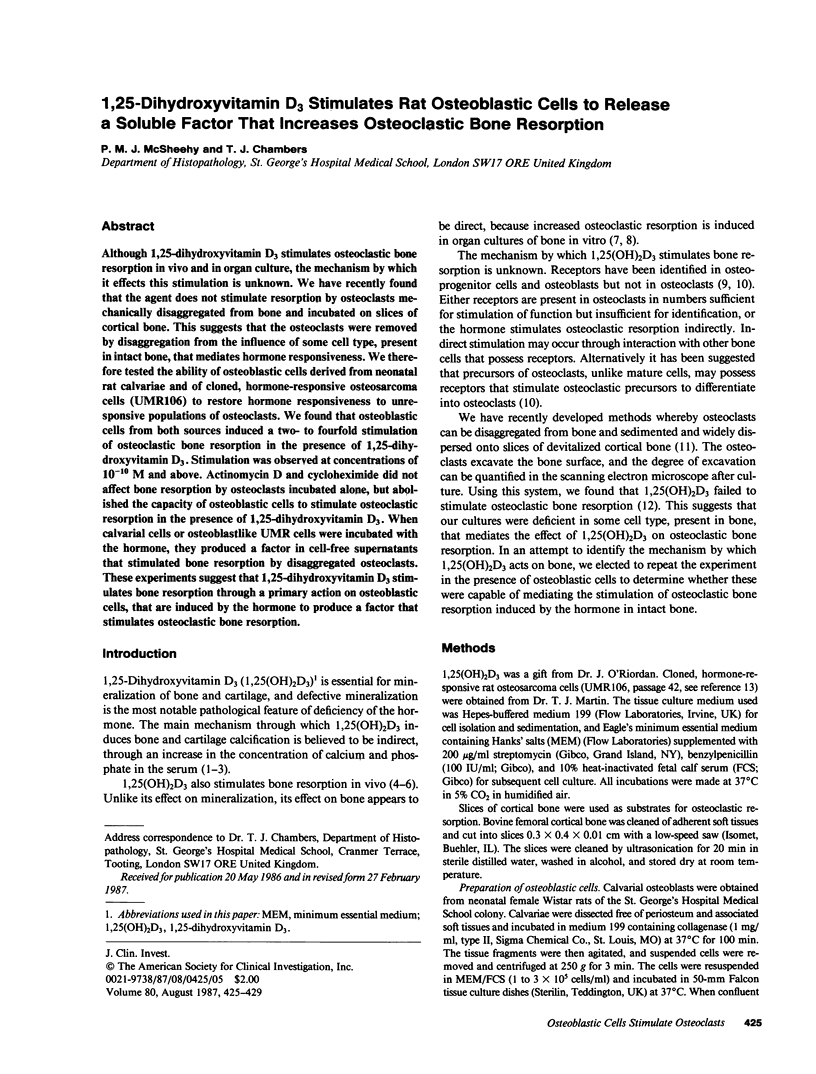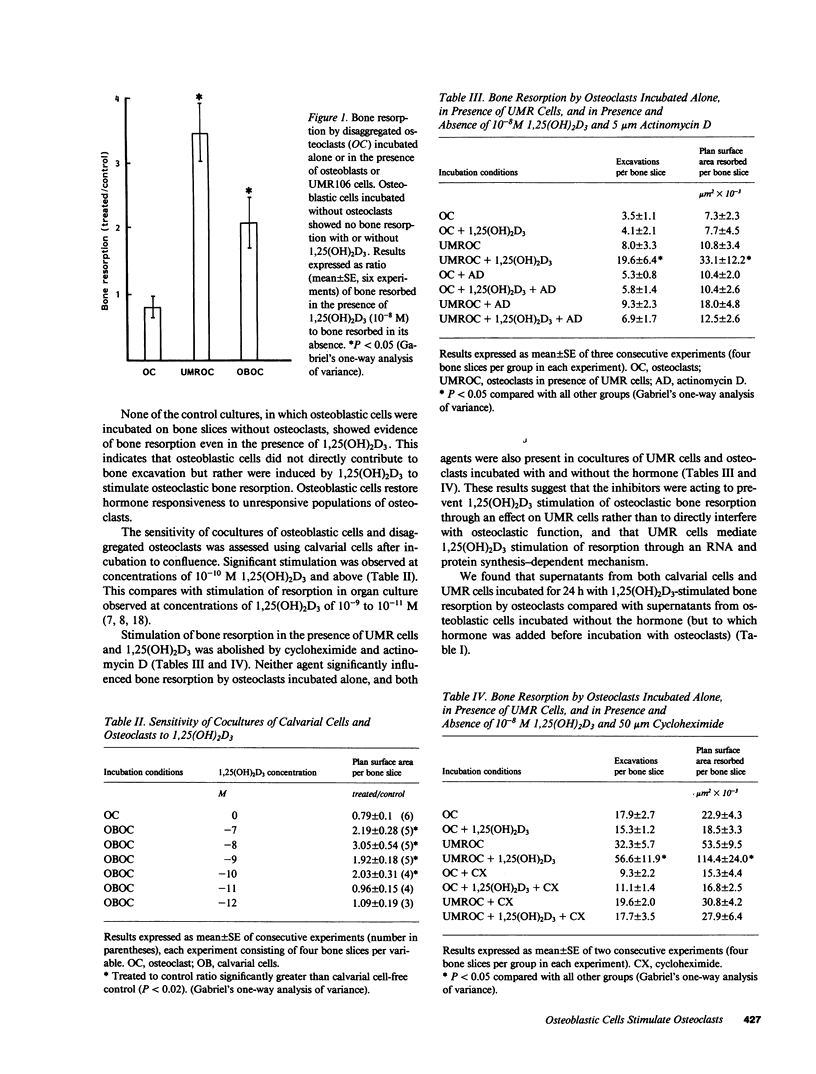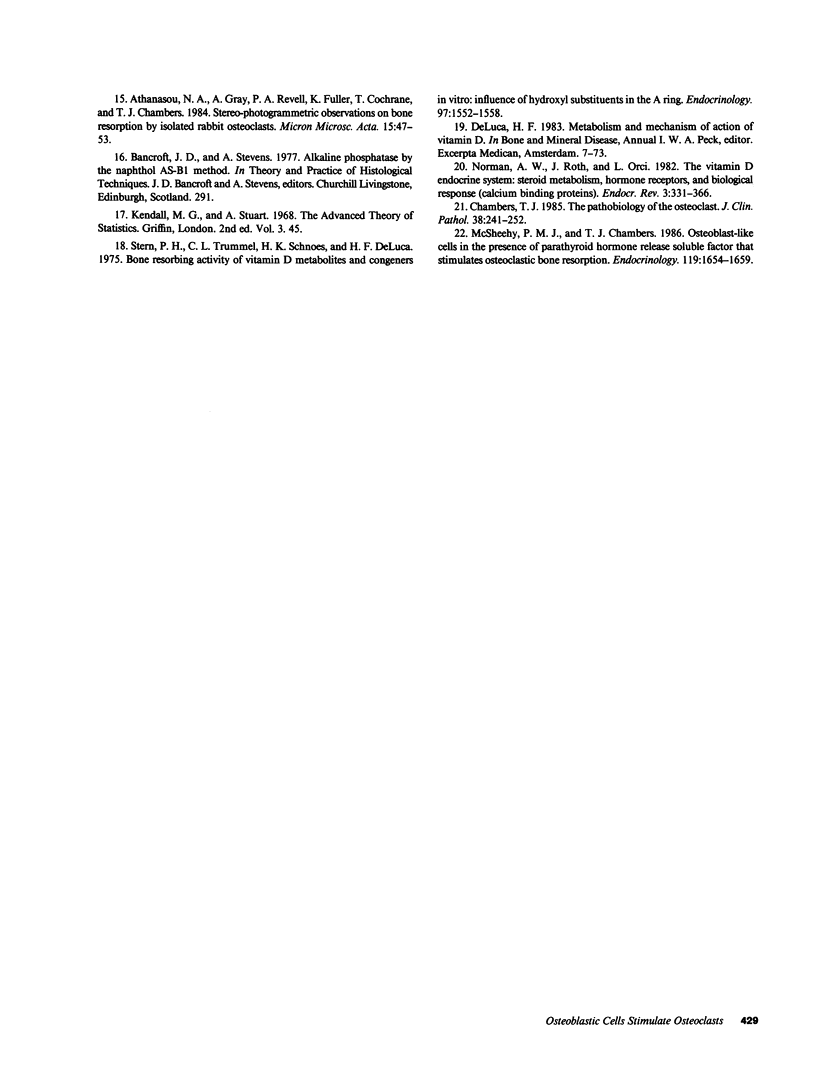Abstract
Although 1,25-dihydroxyvitamin D3 stimulates osteoclastic bone resorption in vivo and in organ culture, the mechanism by which it effects this stimulation is unknown. We have recently found that the agent does not stimulate resorption by osteoclasts mechanically disaggregated from bone and incubated on slices of cortical bone. This suggests that the osteoclasts were removed by disaggregation from the influence of some cell type, present in intact bone, that mediates hormone responsiveness. We therefore tested the ability of osteoblastic cells derived from neonatal rat calvariae and of cloned, hormone-responsive osteosarcoma cells (UMR106) to restore hormone responsiveness to unresponsive populations of osteoclasts. We found that osteoblastic cells from both sources induced a two- to fourfold stimulation of osteoclastic bone resorption in the presence of 1,25-dihydroxyvitamin D3. Stimulation was observed at concentrations of 10(-10) M and above. Actinomycin D and cycloheximide did not affect bone resorption by osteoclasts incubated alone, but abolished the capacity of osteoblastic cells to stimulate osteoclastic resorption in the presence of 1,25-dihydroxyvitamin D3. When calvarial cells or osteoblastlike UMR cells were incubated with the hormone, they produced a factor in cell-free supernatants that stimulated bone resorption by disaggregated osteoclasts. These experiments suggest that 1,25-dihydroxyvitamin D3 stimulates bone resorption through a primary action on osteoblastic cells, that are induced by the hormone to produce a factor that stimulates osteoclastic bone resorption.
Full text
PDF




Selected References
These references are in PubMed. This may not be the complete list of references from this article.
- Chambers T. J., McSheehy P. M., Thomson B. M., Fuller K. The effect of calcium-regulating hormones and prostaglandins on bone resorption by osteoclasts disaggregated from neonatal rabbit bones. Endocrinology. 1985 Jan;116(1):234–239. doi: 10.1210/endo-116-1-234. [DOI] [PubMed] [Google Scholar]
- Chambers T. J., Revell P. A., Fuller K., Athanasou N. A. Resorption of bone by isolated rabbit osteoclasts. J Cell Sci. 1984 Mar;66:383–399. doi: 10.1242/jcs.66.1.383. [DOI] [PubMed] [Google Scholar]
- Chambers T. J. The pathobiology of the osteoclast. J Clin Pathol. 1985 Mar;38(3):241–252. doi: 10.1136/jcp.38.3.241. [DOI] [PMC free article] [PubMed] [Google Scholar]
- Dickson I. R., Kodicek E. Effect of vitamin D deficiency on bone formation in the chick. Biochem J. 1979 Aug 15;182(2):429–435. doi: 10.1042/bj1820429. [DOI] [PMC free article] [PubMed] [Google Scholar]
- Garabedian M., Tanaka Y., Holick M. F., Deluca H. F. Response of intestinal calcium transport and bone calcium mobilization to 1,25-dihydroxyvitamin D3 in thyroparathyroidectomized rats. Endocrinology. 1974 Apr;94(4):1022–1027. doi: 10.1210/endo-94-4-1022. [DOI] [PubMed] [Google Scholar]
- Holtrop M. E., Cox K. A., Clark M. B., Holick M. F., Anast C. S. 1,25-dihydroxycholecalciferol stimulates osteoclasts in rat bones in the absence of parathyroid hormone. Endocrinology. 1981 Jun;108(6):2293–2301. doi: 10.1210/endo-108-6-2293. [DOI] [PubMed] [Google Scholar]
- McSheehy P. M., Chambers T. J. Osteoblast-like cells in the presence of parathyroid hormone release soluble factor that stimulates osteoclastic bone resorption. Endocrinology. 1986 Oct;119(4):1654–1659. doi: 10.1210/endo-119-4-1654. [DOI] [PubMed] [Google Scholar]
- McSheehy P. M., Chambers T. J. Osteoblastic cells mediate osteoclastic responsiveness to parathyroid hormone. Endocrinology. 1986 Feb;118(2):824–828. doi: 10.1210/endo-118-2-824. [DOI] [PubMed] [Google Scholar]
- Merke J., Klaus G., Hügel U., Waldherr R., Ritz E. No 1,25-dihydroxyvitamin D3 receptors on osteoclasts of calcium-deficient chicken despite demonstrable receptors on circulating monocytes. J Clin Invest. 1986 Jan;77(1):312–314. doi: 10.1172/JCI112292. [DOI] [PMC free article] [PubMed] [Google Scholar]
- Narbaitz R., Stumpf W. E., Sar M., Huang S., DeLuca H. F. Autoradiographic localization of target cells for 1 alpha, 25-dihydroxyvitamin D3 in bones from fetal rats. Calcif Tissue Int. 1983;35(2):177–182. doi: 10.1007/BF02405028. [DOI] [PubMed] [Google Scholar]
- Norman A. W., Roth J., Orci L. The vitamin D endocrine system: steroid metabolism, hormone receptors, and biological response (calcium binding proteins). Endocr Rev. 1982 Fall;3(4):331–366. doi: 10.1210/edrv-3-4-331. [DOI] [PubMed] [Google Scholar]
- Partridge N. C., Alcorn D., Michelangeli V. P., Kemp B. E., Ryan G. B., Martin T. J. Functional properties of hormonally responsive cultured normal and malignant rat osteoblastic cells. Endocrinology. 1981 Jan;108(1):213–219. doi: 10.1210/endo-108-1-213. [DOI] [PubMed] [Google Scholar]
- Raisz L. G., Trummel C. L., Holick M. F., DeLuca H. F. 1,25-dihydroxycholecalciferol: a potent stimulator of bone resorption in tissue culture. Science. 1972 Feb 18;175(4023):768–769. doi: 10.1126/science.175.4023.768. [DOI] [PubMed] [Google Scholar]
- Reynolds J. J., Holick M. F., De Luca H. F. The role of vitamin D metabolites in bone resorption. Calcif Tissue Res. 1973;12(4):295–301. doi: 10.1007/BF02013742. [DOI] [PubMed] [Google Scholar]
- Stern P. H., Trummel C. L., Schnoes H. K., Deluca H. F. Bone resorbing activity of vitamin D metabolites and congeners in vitro: influence of hydroxyl substituents in the A ring. Endocrinology. 1975 Dec;97(6):1552–1558. doi: 10.1210/endo-97-6-1552. [DOI] [PubMed] [Google Scholar]
- Underwood J. L., DeLuca H. F. Vitamin D is not directly necessary for bone growth and mineralization. Am J Physiol. 1984 Jun;246(6 Pt 1):E493–E498. doi: 10.1152/ajpendo.1984.246.6.E493. [DOI] [PubMed] [Google Scholar]
- Wong R. G., Myrtle J. F., Tsai H. C., Norman A. W. Studies on calciferol metabolism. V. The occurrence and biological activity of 1,25-dihydroxy-vitamin D 3 in bone. J Biol Chem. 1972 Sep 25;247(18):5728–5735. [PubMed] [Google Scholar]


